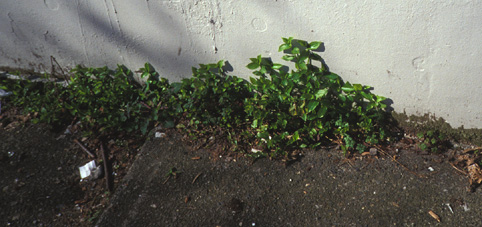
|
Wandering Jew houseplant growing in a Seattle alley
|
Heat and Cold in Seattle
|
| Summer's warmth allows Seattle gardeners to grow
heat-needing plants. Edible examples are tomatoes, basil, eggplant, peppers and
melons. Ornamentals include Salvia,
Ipomea, Begonia and many
houseplants. All of these plants luxuriate until autumn's icy touch turns them
into gooey pulp resembling cooked greens. Every once in a while there will
be a lucky plant, well sited, and a mild winter, so the eventual death
is postponed. Some houseplants such as spider plant and wandering
jew have survived outdoors here through winter, for at least a year or
two. Eventually an old fashioned winter kills them. Some local
gardeners, completely fed up with winter, use greenhouses or grow lights
to overwinter a bit of summer splendor. |
| Another contingent, myself included, delights in planting
species which will just barely, if at all, survive outside through winter. There
is some fun in winning, in beating the odds. If our plant experiments
die from cold, we're not shocked; if they live we're smug and delighted.
We choose varieties carefully, plant them in protected spots, and
maintain ideal soil conditions. The same plant, say a cactus, may die if in rich,
moist garden soil, yet thrive if planted on a pile of coarse sand and grit. |
| In general, the warmest place is right against a building on a south
or southwest facing side, preferably under eaves or overhangs. Such
spots are veritable ovens in summer, but don't readily freeze in winter. On
the other hand, the coldest spot would likely be in a low, exposed area,
where vicious winds roar, and the dim winter sun does minimal
warming. Higher elevations are also colder, and the farther one travels from the
heat of the big city the colder. North Seattle is significantly colder than
south Seattle. Forested areas are both cooler in summer and warmer in
winter than open areas. |
Masses of concrete and lots of automobiles makes for urban
"heat islands" such as under parts of I-5, the Alaskan viaduct, and the like.
All manner of plants live and bloom there throughout the winter. Such
spots also serve as magnets to many homeless people. Too bad: if there
wasn't so much concentrated pollution in these places, edible crops could
be raised easily. Failing that, guerrilla gardeners in search of
adventurous beautification thrills could do worse than try planting
Bougainvillea vines, certain palms and eucalypts. Why not? In most such concrete
hot spots all one sees is wild brush, vines and acres of weeds, or
asphalt parking lots.
|
(originally published in The Seattle Weekly, July 1997)
Back |
|
|

